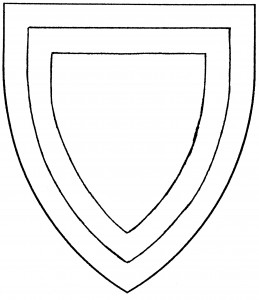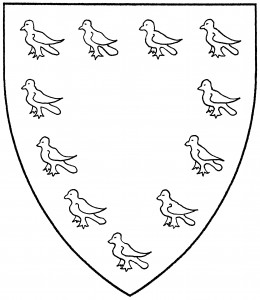The orle is an heraldic ordinary, a band parallel to the edge of the shield; its width is typically one-tenth to one-twelfth that of the shield. Its original form was as an escutcheon voided, which form dates to c.1255 in the arms of Balliol [ANA2 503]; but unlike an escutcheon voided, which is always escutcheon-shaped, the orle conforms to the shape of the field it charges. As an ordinary, it is subject to most of the usual treatments.
The diminutive of the orle is the “tressure”; the term is used when there are two or more of the charge. The number is given as, e.g., a “double tressure” or “triple tressure”. Double tressures are found as early as 1280, in the arms of the Kings of Scots [ANA2 103]. The tressures used in Scotland’s arms, the “double tressure flory counter-flory”, are granted by the Crown of Scotland as an augmentation, and not permitted in Society heraldry; even charges suggestive of the Scots tressures, such as the orle demi-flory, are disallowed. (The arms of Scotland at one point used an orle flory counter-flory, c.1244 [Asp2 208], so the prohibition has some historical basis.) Although in theory a double tressure could be surmounted by charges other than fleurs-de-lys – e.g., a double tressure surmounted by mullets – no period examples have been found, and the practice is considered a step from period practice.
The term “orle” had another usage in medieval blazons, predating its application to the escutcheon voided: it described an unnumbered group of charges arranged around the edge of the shield, where the edge of a bordure would be. Thus, in the arms of the Earls of Pembroke, c.1244 [ANA2 210], a group of martlets around the shield’s edge (as shown in the illustration) would be blazoned “an orle of martlets”. Note that the charges in the orle are all in their default orientation; if the charges are to orient themselves parallel to the edge of the shield, Society blazon would use the term “an orle of [charges] in orle”.
Frithiof Sigvardsson Skägge bears: Gyronny argent and vert, an orle sable.
Padraig Ó Taidg bears: Azure, a double tressure argent.
Rowan of Hakesleah bears: Gules, an orle of escallops Or.
Geoffrey le Bay bears: Sable, an orle of plates.

